History of the Development of Ultrasound Technology
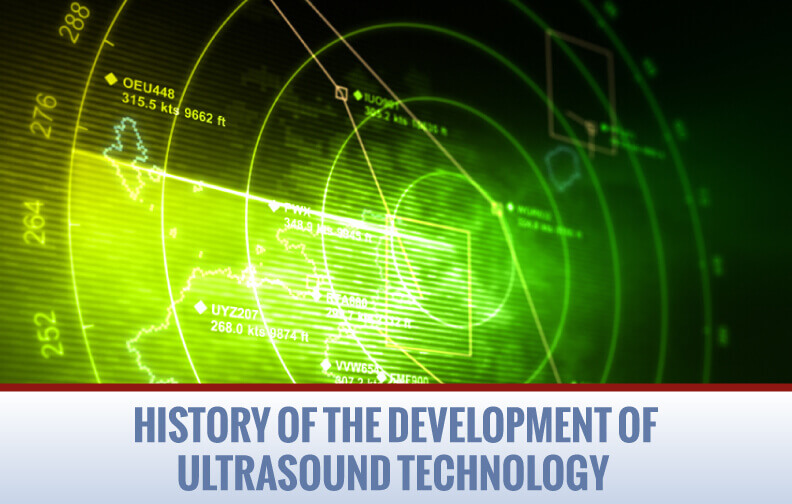
The science of sound is an ever-evolving and vast study. It is documented as far back as the sixth century BC when Greek philosopher and mathematician Pythagoras constructed mathematical properties of stringed instruments. Sound waves, whether heard audibly or at such a high frequency that they cannot be heard by the human ear, have been constantly investigated over the years by scientists, engineers, doctors and individual entrepreneurs.
Many different industries benefit from the advancement of ultrasound technology. Ultrasonic devices can detect objects, measure distances, deep clean, aid in manufacturing and improve medical care and treatment. The uses continue to grow as advancements are made in the fabrication of the ultrasonic components, often providing a less invasive and lower-cost alternative.
Discovery of Ultrasound Technology
Sound waves have been studied for many different reasons for hundreds of years, but the development of ultrasound had its beginning in 1790 with the discovery of echolocation used by bats. Biologist Lazzaro Spallanzani first documented this ultrasonic ranging as their mode of flight, using their hearing to maneuver through the air by listening for the return of the high-frequency sound they emit to detect objects and food.
These high-frequency sound waves set the stage for the future development of ultrasonic technology. There were a few discoveries in the late 18th and 19th centuries that aided in this development, but Spallanzani’s document was 100 years before there was an actual development that humans could harness and use.
The most notable breakthrough came in 1880 when physicist Pierre Curie and his brother Jacques Curie advanced their knowledge of pyroelectricity, which is the electric potential generated by a material in response to a temperature change. They also studied the properties of the crystal structure to demonstrate a piezoelectric effect that was the scientific basis of the first transducer. This device generated a high-frequency sound and then received its echo.
The First World War spurred many technological advancements in a number of industries, and ultrasound technology was of special interest to the military at the time. A sonar device was the first practical application of ultrasound and piezoelectric technology that was developed during World War I to detect submerged submarines. The early 1900s was an exciting time of discovery and development for ultrasonics, and the potential for this branch of physics and engineering was applied to many different industries.
Here are the greatest historic applications of ultrasound technology with details about their beginnings:
SONAR – Sound Navigation and Ranging
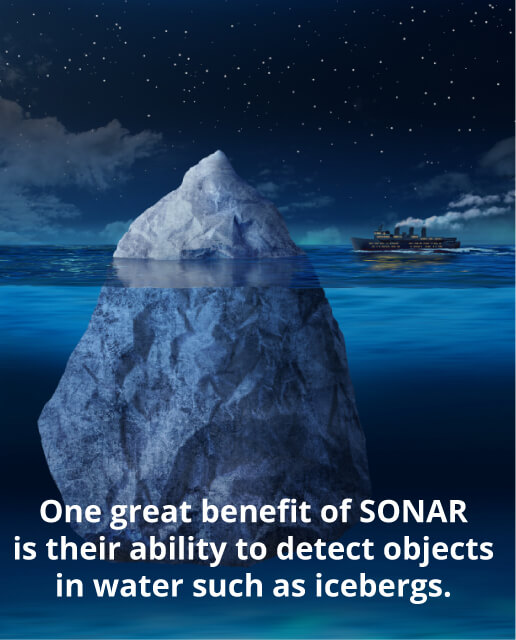
Detecting icebergs was a great benefit for the navigation of ships after the Titanic sank in 1912. The hydrophone was invented by 1916. This was the first transducer, which was an electric oscillator that emitted and received a high-frequency signal to indicate the presence of objects in the water. It consisted of several thin, inter-spaced quartz crystals that were glued between two steel plates and emitted a frequency of 150 KHz. By the mid-1930s, most ocean liners had some type of sonar device.
RADAR – Radio Detection and Ranging
Using electromagnetic waves rather than sound waves to detect objects in the air was another way ultrasound technology advanced. These radar display systems provided direct data that was later used in the development of ultrasound in the medical field and two-dimensional sonars.
Engineering Technology
Improvements and new discoveries in the field of engineering were vital to the ongoing development of sonar technology. They added to the experience of compiling and displaying data with the invention of the first digital computer in 1945 and the point-contact transistor in 1947.
Metal Flaw Detection
The late 1920s brought discoveries for the benefit of ships and other large metal objects, which were continually improved on and adopted in several different industries. Scientist Sergei Sokolov demonstrated a through-transmission technique in the mid-1930s to detect flaws in metals, but the technology was not advanced enough for adequate resolution.
However, this proved to be another building block to ultrasound development. Technology caught up to Sokolov’s discoveries in the late 1930s into the early 1940s. Various devices were produced with his reflection technique, which involved the transmission of a pulsed sound wave to a solid object and the return to a receiver at the starting point.
Initially, this technology was used to detect flaws in the metal hulls of ships and armor plates of battle tanks. It wasn’t long, though, before this practical application found its way into technology for radar and underwater navigation, as well as various other types of metal fabrication.
Medical Treatments That Use Ultrasonic Technology
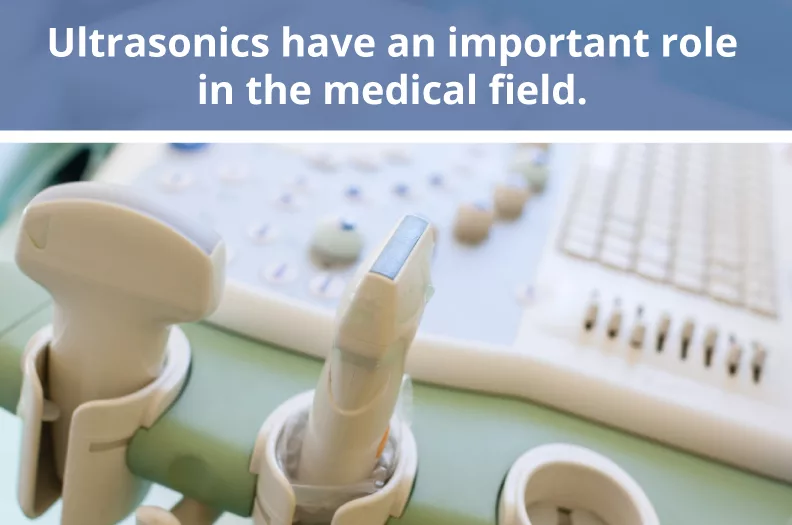
Ultrasonics were first used in the medical field as a form of therapy to treat diseases and disorders affecting tissue in the body. The heating and destructive properties of high-intensity sound waves were recognized in the 1920s and 1930s through research relating to sonar devices. They were then adapted as a beneficial neurosurgical tool.
The 1940s brought a great influx of ultrasonic treatments to the medical world, treating a rash of ailments such as the following:
– Rheumatic arthritis
– Meniere’s disease
– Gastric ulcers
– Eczema
– Hemorrhoids
The growing claim of ultrasound as a common “cure-all” therapy slowly fell out of favor as concerns over tissue damage became more wide spread. It has, however, maintained its favor in physical therapy, rehabilitation and pain relief.
A lasting and beneficial medical application began in the 1940s for diagnostic uses. With the technique of echo-reflection, as was used in the detection of metal flaws, researchers developed a method for detecting tumors, exudates and abscesses. Medicine was realizing the benefits of ultrasound at this time. New discoveries related to electronics and manufacturing processes could support the growing discoveries of ultrasonics with advancing technology that took off after World War II.
The earliest concept of scanning body organs came in the form of the through-transmission technique that required transducers placed on either side of the head. Part of the patient’s head and the transducers were stationed in a water bath. The sound waves moving between the transducers were photographically recorded on heat sensitive paper as light spots, which is not the same technology produced today for body scans, but was an instrumental design in the history of medical diagnosis using ultrasound.
Sterilization, Scouring and Decontamination
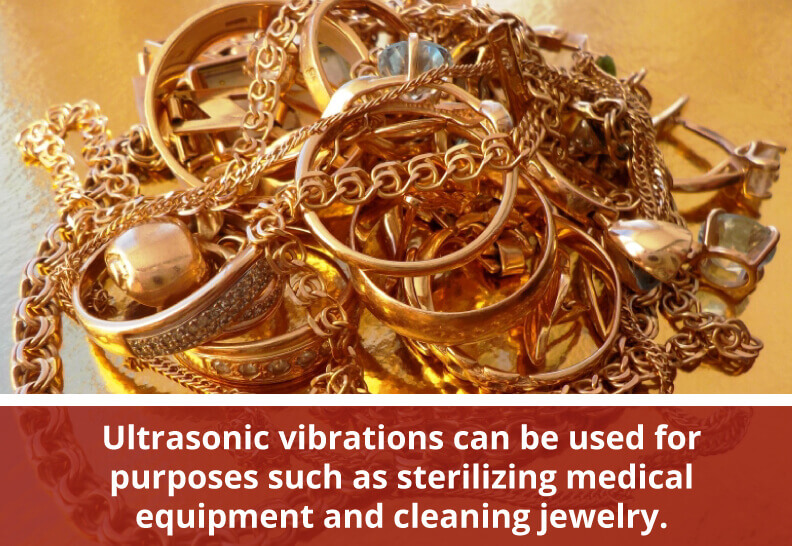
The process of cavitation blasts a surface clean by producing ultrasonic vibrations within a liquid, which creates millions of bubbles that collapse thousands of times a second. Common use of ultrasonic cleaning began around 1950 in industrial environments and became an inexpensive option for small businesses and home use by the 1970s. Some of the uses of this process included the following:
– Sterilization of medical equipment
– Jewelry cleaning
– Decontamination of radioactive equipment
– Scouring of precision metal parts
Precision Carving and Drilling
Ultrasonic machining uses an abrasive slurry that surrounds the material while the tool oscillates at high frequencies. It’s used as a non-contact form of grinding on hard and brittle materials like glass, crystals and ceramics. The tiny particles of the abrasive are pushed against the material with an extreme impact to produce precision shaping with little heat production.
Joining Plastics and Metals
The manufacturing industry first used ultrasonic welding for fine wire bonding in electronics. Although technology was available as far back as the late 1940s, it wasn’t until 1960 that the first patent was granted for an ultrasonic metal welding process. The U.S patent for the ultrasonic method for welding rigid thermoplastic parts was awarded in 1965 when it was discovered that sound waves moved around corners and down the sides of hard plastics to reach a section to be joined.
History of Use of Ultrasonic Components: Piezo Devices and Systems
Many discoveries in the field of ultrasound opened up great opportunities for new industries or improved technology to bring new ways to transfer sound waves and to more accurately analyze data. Recently, equipment has become more portable or so small that it can be held in one hand. Other devices make new medical procedures less invasive and more accurate, giving the medical community more options and better outcomes.
Many industries benefited from the discovery and development of piezoelectricity. The potential for this technology was realized in a variety of industries. Uses for ultrasound multiplied from 1940 to 1980 in commercial applications and for personal use.
Pre-1940
Before 1940, the scientific community worked to improve various kinds of piezoelectric devices using natural crystals. Some of the most notable advancements included:
– A dramatic increase in stability with megacycle quartz resonators that were created as frequency stabilizers in vacuum-tube oscillators
– The invention of devices still used today, such as microphones, phonograph pick-ups, ultrasonic transducers, bender element actuators, accelerometers and signal filters
– New methods of testing liquids and solid structures that were developed based on the propagation of ultrasonic waves, such as the ability to identify properties of viscosity and elasticity of liquids and to detect cracks and flaws in metal structures
– Previously unmeasurable vibrations, accelerations and impacts, which opened the door to further study internal combustion engines and explosives
First Influx of Development: 1940-1965
The years between 1940 and 1965 fueled a new wave of research and development. Scientific discoveries included doping the barium titanate and lead zirconate titanate families of piezoceramics with metallic impurities to achieve certain properties of dielectric constant, ease of poling and piezoelectric coupling coefficients.
There was also a greater understanding of the relationship between the perovskite crystal structure and electro-mechanical activity. These advances tailored a material to a specific application and were fundamental to the growing method of piezoelectric development.
World War II created definite interest in improving piezoelectricity, which propelled abundant research and development to further the performance and manufacturing practices of piezoelectric components. The biggest achievements of this time were the discovery of certain ceramic materials that:
– Showed dielectric constants up to 100 times higher than natural crystals
– Exhibited great improvements in piezoelectric properties
– Were easily manufactured
Sonar devices became more powerful with ceramic casting, allowing for different transducer designs using spheres and cylinders. Electronic circuits became cheaper with the implementation of ceramic phone cartridges. Small and sensitive microphones were readily manufactured. Snap action relays began to be produced with piezoelectricity. The physics research and engineering development was in high gear during this time with the creation of piezoceramic materials that would be the foundation for the influx of product development in the coming decades.
A solid technology allowed for the development of smaller and cheaper ultrasound devices with the invention of the point-contact transistor around 1947, which revolutionized the electronics industry.
Commercial Influx in Development: 1965-1980
Starting in 1965, the commercial potential of ultrasonic applications took off in a variety of industries. Medical advances improved devices built on:
– The detection of tumors
– Body scanning
– Cardiac-related diagnoses
– Doppler ultrasound
– The B-mode scanner
With several breakthroughs in material research the 60s, 70s and 80s, new piezoceramic families were developed to complement the increase in the electronic equipment and appliance market with a range of piezoceramic signal filters.
There was much research and component development to come, and the retail market was filled with piezoelectric technology, such as:
– Audio buzzers in smoke alarms and tone generators
– Air ultrasonic transducers used in television remote controls and security alarms
– SAW filter devices using Surface Acoustic Wave to filter high-frequency signals
Continuing Development – Ultrasound Technology Today
From the 1980s to present day, the manufacturing of piezo products has been in a continual state of expansion. The discovery of ceramics in piezoelectricity has provided the industry with flexibility in applications and an ongoing source of new developments of both applications and material improvements.
Increasing Uses of Ultrasound
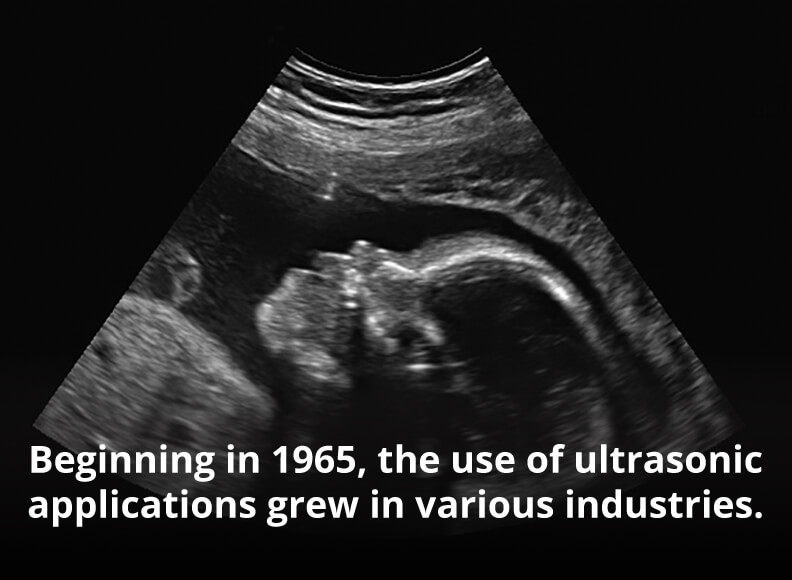
Since the first real-world application of piezoelectricity for sonar in 1917, there has been substantial development in this industry. From direct use in the human body to the many other uses for ultrasound technology, the ongoing demand for low- and high-frequency applications of piezoelectricity will bring many more new opportunities.
The creation and improvement of piezo products — such as piezoelectric materials, stack actuators, piezo disc benders or piezo sensors — has provided humanity many benefits. The medical community a clearer look in the body, the transportation industry has advanced technology for detection and navigation, the food industry has comprehensive analytical and monitoring techniques, and the welding industry has cost-effective and safer methods of joining materials.
The majority of homes and businesses today use some type of piezoelectric technology in their daily operations. As technology continues to move forward, so will the technology in transducers and other piezoelectric components. New manufacturing processes will continue to emerge and ongoing research will uncover more of the unknown. We’ll see dramatic improvements, such as those with 2-D and 3-D imaging, increased production and energy efficiency, software-based image processing and scan converting, and high-functioning devices that will become smaller and smaller in size.
To learn more about our piezo products and processing services call 570-726-6961 or fill out our online contact form.
Read More Popular Posts From APC International
Top Uses of Piezoelectricity in Everyday Applications
Piezo Buzzers vs. Magnetic Buzzers
Principles of Piezoelectric Energy Harvesting
Self Charging Power Cells and Batteries
Overview of Piezoelectric Materials in Energy Harvesting


No Comments